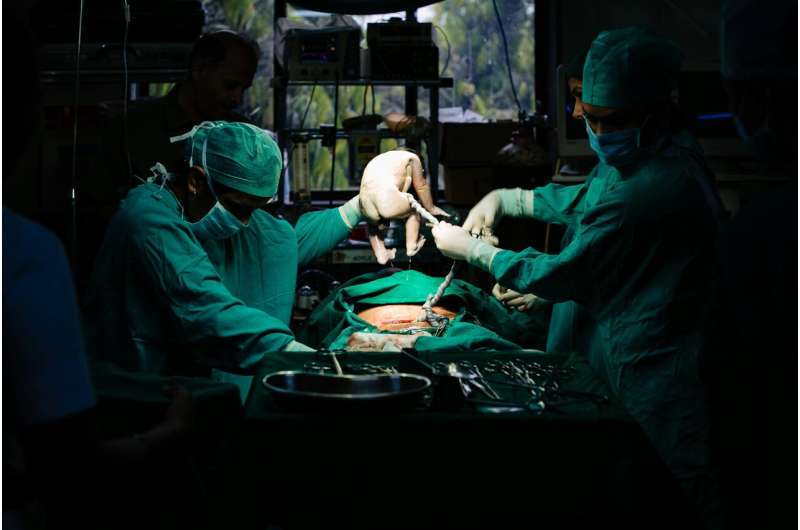Some private UK biobanks may be misleading expectant parents about the value of storing umbilical cord blood to treat life-threatening diseases that may arise in their child in the future, reveals an investigation by The BMJ.
Over the past decade, growing numbers of parents have chosen to store blood from the umbilical cord, which contains stem cells, in case their infant develops a condition that could be treated with stem cell therapy.
Ruehlmann says another unknown is how this process impacts children once they are born.
“We found five specific locations of DNA methylation with three different maternal stressors during pregnancy,” she says. “One was cumulative stress and the stressor specific domains of conflict with family/friends, abuse (physical, sexual and emotional) and death of a close friend/relative that were associated with DNA methylation in the developing fetus. These were occurring in genes that have shown to be involved in neurodevelopment. The next steps are to do some functional analyses to see how these genes really work and how the DNA methylation affects their expression.”
Ruehlmann describes the process as being a huge puzzle.
“Epigenetic modifications are a very dynamic process, there are a lot of changes that can happen in response to environmental factors,” she says. “What you’re seeing biologically at the beginning of fetal development you might not see the outcome of until later on during a child’s development. It’s fascinating as a biologist to begin to uncover some of the biological clues to how neurodevelopment is affected during fetal development. There are a lot of pieces to the puzzle that have yet to be connected. It’s very exciting.”
Luis D. Pacheco, M.D., from the University of Texas Medical Branch in Galveston, and colleagues randomly assigned patients undergoing cesarean delivery at 31 hospitals to receive tranexamic acid or placebo after umbilical cord clamping (5,529 and 5,471 participants, respectively). The primary outcome was a composite of maternal death or blood transfusion by hospital discharge or seven days postpartum.
The researchers found that a primary outcome event occurred in 3.6 and 4.3 percent of participants in the tranexamic acid and placebo groups, respectively (adjusted relative risk, 0.89; 95.26 percent confidence interval, 0.74 to 1.07; P = 0.19). Estimated intraoperative blood loss of more than 1 L occurred in 7.3 and 8.0 percent of those in the tranexamic acid and placebo groups, respectively (relative risk, 0.91; 95 percent confidence interval, 0.79 to 1.05). Interventions for bleeding complications occurred in 16.1 and 18.0 percent of those in the tranexamic acid and placebo groups, respectively (relative risk, 0.90; 95 percent confidence interval, 0.82 to 0.97). The two groups had similar frequencies of thromboembolic events and other adverse events.
“Prophylactic administration of tranexamic acid during cesarean delivery did not lead to a lower risk of maternal death or blood transfusion,” the authors write.
A new method to cure HIV—by transplanting HIV-resistant stem cells from umbilical cord blood—has yielded long-term successful results, say scientists. The approach was successfully used to treat the “New York patient,” a middle-aged woman with leukemia and HIV who self-identifies as mixed race, who has been without HIV since 2017. Using stem cells from cord blood rather than from compatible adult donors, as has been done previously, increases the potential to cure HIV via stem cell transplantation in people of all racial backgrounds.
In addition to showing a decrease in the chance of graft-versus-host disease, which develops when a transplanted blood system attacks a patient’s tissues, the study shows a slightly lower rate of relapse in these patients undergoing transplant with cord blood.
“Especially with younger, fitter patients who we can hit harder in the transplant process, we have strong hints here that cord blood may be actively better in terms of reducing both graft-versus-host disease and relapse,” Gutman says.
Umbilical cord blood, which is banked for public use at designated centers around the world, is rich in stem cells, which can repopulate a patient’s blood system. Because these umbilical cord stem cells are more “basic” than adult blood cells, they require a lower degree of match than blood cells from an adult donor. However, one challenge has been obtaining enough of these cells to perform a successful transplant.
“It turns out that for adults, it’s very hard to find a single cord blood unit that meets the parameters we know need to be met in terms of size. To overcome this barrier, we often use two units from different sources,” Gutmans says. Also, research at CU Cancer Center and elsewhere is developing techniques to expand small samples of banked cord blood to the volume needed for transplant.
“We think there are important advantages of cord blood, especially with respect to graft-versus-host disease,” Gutman says. “Previously, we’ve taken a position recommending cord blood over matched unrelated donors, and now we show that cord blood may even out-compete the gold standard of matched sibling donors.”
